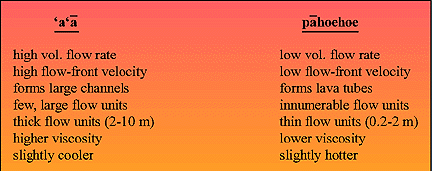The major eruptive product of Hawaiian volcanoes is lava. Lava flows can form during fountaining eruptions or they can well out of the ground with little or no pyroclastic activity. There are two major types of basaltic lava flow, 'a'a and pahoehoe. These are Hawaiian words that have no meaning other than the type of lava, and they have been adopted by geologists working in other basaltic areas besides Hawai'i. They are different in almost every respect possible except for their chemistry.
Pahoehoe flow (left) flowing over older 'a'a, and in front of an advancing 'a'a flow (background). Note the continuous skin of the pahoehoe being crumpled at the flow front, and compare it to the broken clinker of the active 'a'a. Note also that the pahoehoe flow front is ~30 cm thick whereas the 'a'a flow front behind is almost 2 m high.

All their myriad differences can be attributed to different eruption and consequent emplacement mechanisms.